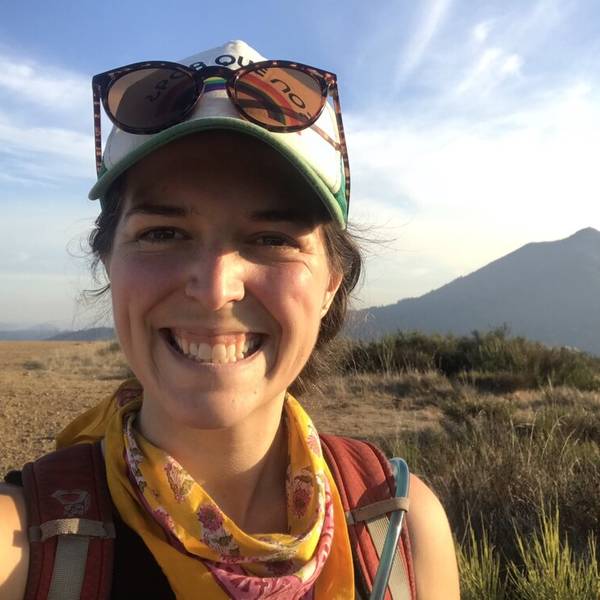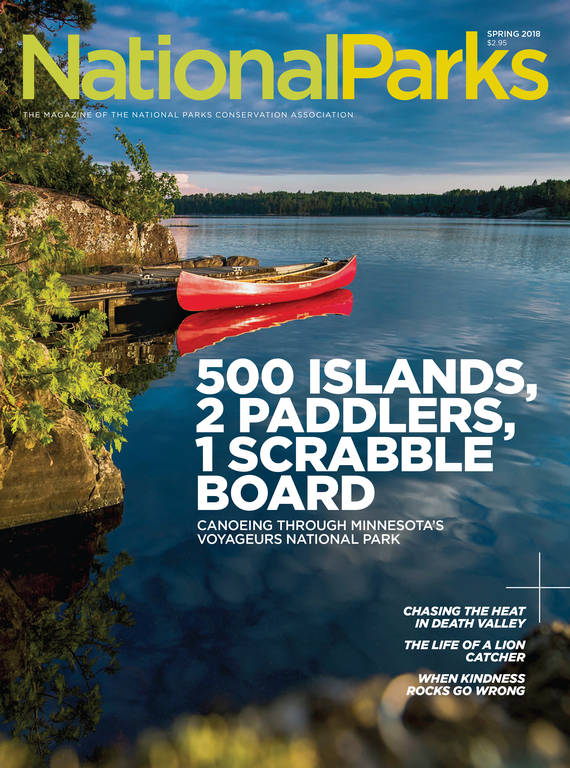Spring 2018
Nature’s Night Lights
After the sun sets, the bioluminescent show on Tomales Bay begins.
“Is it happening?” I asked.
I looked over my shoulder at my friend and kayak co-pilot, Liz, who had stopped paddling and was leaning over the edge of the boat, looking intently at the water. She dipped her hand in, swirled her fingers experimentally, then looked up at me. It was a pitch-dark night, but I could still make out a smile lighting up her face. “It’s definitely happening,” she concluded.
Liz and I were drifting in a double kayak on Tomales Bay, the long, skinny slice of seawater that sits next to California’s Point Reyes National Seashore. We’d come in search of dinoflagellates — single-celled organisms found in all the world’s oceans. Dinoflagellate populations respond quickly to variations in water temperatures, weather conditions and nutrients, so scientists learn a lot about ocean chemistry and biology from studying them. The organisms also play a foundational role in the marine food web: They photosynthesize, turning energy from the sun into food for all the ocean’s animals. The tiniest zooplankton eat them, and in turn feed a web of life all the way up to the mightiest whales.
But Liz and I aren’t scientists, and we were definitely not there to eat. We were there because some species of dinoflagellates actually glow from within — a phenomenon known as bioluminescence. And when conditions are right, the ocean’s surface lights up at the slightest touch, giving off an alien glow that rivals a sci-fi movie’s special effects.
If the amazement on Liz’s face was any indication, conditions were right. So I took a big paddle stroke, and I watched closely. As the blade pulled through the water, I saw its wake glimmer below the surface. At first the effect was faint and fleeting, a cool, pale glow that flickered out after a second or two. I submerged my hand, and each finger left its own trail of sparkles as the kayak glided ahead.
Scientists think that dinoflagellates glow — or bioluminesce — primarily for self-defense (the flash they emit when their cell walls detect pressure is the result of a chemical reaction and seems to deter some predators). Bioluminescence is actually a fairly common trait in ocean life. Sea stars, bony fish, crustaceans, squid, and even some whales and sharks glow to warn, stun, distract, illuminate and attract other creatures.
But on Tomales Bay, dinoflagellates steal the show. We’d set out at sunset on a still October night with a group led by a local outfitter, dozens of people hoping to witness the phenomenon before winter weather ended bioluminescent viewing season and made nighttime trips too dangerous. We paddled across the bay, subject to scrutiny by passing pelicans and seals groaning from shore. Big waves boomed at the mouth of the bay a mile or so north, but in the bay, the water was perfectly flat. The Milky Way splashed across the sky, and every few minutes, a shooting star blazed overhead, thanks to the Orionid meteor shower.
It takes only an hour to get from downtown San Francisco to this part of Marin County, a wildly popular playground for millions of Bay Area residents. The western shore of Tomales Bay is part of Point Reyes National Seashore, and much of the eastern shore is state parks or private ranchlands. That’s one reason this spot is frequented by star-gazers and bioluminescence hunters like us: Though it’s close to a big urban center, there are no city lights to mask the glow from above or below.
After paddling the mile or so across the bay, we were bobbing up against hulking, uninhabited cliffs on the national seashore. As our eyes adjusted to the darkness, the bioluminescence seemed to glow brighter by the paddle-stroke. The other folks in our group were noticing it by then, too, and we could hear gasps and cries — and lots of splashing — from the other kayakers. A pair ahead of us paddled furiously for a few strokes, and once they got up to speed, their boat carved a shimmering blue bow wave through the black, glassy surface of the bay.
Autumn on Tomales Bay, when it’s typically tranquil and sunny, is high time for bioluminescence. “Dinoflagellates prefer calmer conditions, when the water column is more stratified. You’ll find a stable warm layer at the surface and a colder layer at depth,” said John Largier, a coastal oceanographer at the University of California Davis Bodega Marine Laboratory. Dinoflagellates’ delicate tails — or flagella —enable them to migrate through these layers from the shallows, where they can catch the sun’s rays, to the colder depths, which are richer in nutrients. Along the Northern California coast, the population blooms during periods of calm weather in autumn, then stops growing when winter weather returns and churns up the seas.
The keyword is “typically,” a term that climate scientists say is increasingly difficult to define. The winter of 2017 was off to an unusually dry and sunny start in California. “Our good bioluminescent viewing season, which has usually ended in early October, has gone on well into December,” said John Granatir, who has been guiding nighttime kayak tours on Tomales Bay for seven years. “That’s giving more people a chance to get out and give it a look, and there’s definitely a lot of interest as the word is getting out. The nighttime tours book up months in advance.”

National Parks
You can read this and other stories about history, nature, culture, art, conservation, travel, science and more in National Parks magazine. Your tax-deductible membership donation of $25 or more entitles…
See more ›In recent years, researchers at the Monterey Bay Aquarium Research Institute have also observed an increase in dinoflagellate populations off some parts of the California Coast. This population growth coincided with “the Blob,” the mysterious mass of unusually warm ocean water that plagued the West Coast from late 2013 to early 2017. Scientists say the Blob caused die-offs in marine wildlife and persistent toxic algal blooms, and it correlated with weird weather from Mexico to Alaska. “Here in Northern California, the Blob meant that autumn-like conditions reigned from June through the end of the year for some years in a row,” Largier said. “We had warmer, calmer water for longer than usual.” The Blob seems to have dissipated for now, but scientists wonder if we’ve just seen a preview of how a warming climate will affect the world’s oceans.
Blob or no Blob, Liz and I encountered the perfect evening for appreciating bioluminescence on Tomales Bay. Even in October, calm conditions are not guaranteed, and moonlight can dim the underwater show. But the moon had sunk below the horizon, and we made the most of the clear, still night. We paddled aimlessly for hours, drawing shimmering shapes on the surface and tossing sparkling handfuls of seawater that splashed down in a cool blue burst of bioluminescent fireworks.
Finally, we headed back to shore, hauled out our kayak, peeled off wet layers and split a thermos of hot tea we’d stashed in the car. Then we drove home, reluctant to return to the bright lights of the city.
About the author
-
 Julia Busiek Author
Julia Busiek AuthorJulia Busiek has worked in national parks in California, Colorado, Hawaii and Washington state. She lives in Oakland, California.



